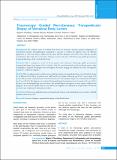Please use this identifier to cite or link to this item:
https://hdl.handle.net/20.500.14356/1379| Title: | Fluoroscopy Guided Percutaneous Transpedicular Biopsy of Vertebral Body Lesion |
| Authors: | Chaudhary, Rajesh Kumar Acharya, Shankar Chahal, Rupinder S Kalra, Kashmiri L |
| Citation: | ChaudharyR. K., AcharyaS., ChahalR. S., & KalraK. L. (2019). Fluoroscopy Guided Percutaneous Transpedicular Biopsy of Vertebral Body Lesion. Journal of Nepal Health Research Council, 17(2), 163-167. https://doi.org/10.33314/jnhrc.v0i0.1863 |
| Issue Date: | 2019 |
| Publisher: | Nepal Health Research Council |
| Article Type: | Original Article |
| Keywords: | Accuracy Adequacy Transpedicular biopsy Vertebral body lesion |
| Series/Report no.: | Apr-June, 2019;1863 |
| Abstract: | Abstract Background: The common causes of vertebral body lesion are metastasis, infection, primary malignancies or osteoporotic fractures. Histopathological examination is necessary to confirm the diagnosis. There are different approaches to collect the biopsy samples and they have different adequacy and accuracy rates and also possible complications. This study aims to determine adequacy, accuracy and safety of the fluoroscopy guided percutaneous transpedicular biopsy of the vertebral body lesion. Methods: This is retrospective review of all the patients who underwent fluoroscopy guided percutaneous transpedicular biopsy from January 2013 to October 2016. We reviewed medical records and biopsy reports, plain radiographs, Computed Tomography Scan and Magnetic Resonance Imaging and additional necessary investigations required to confirm the diagnosis. Results: Fifty two patients underwent fluoroscopy guided percutaneous transpedicular biopsy of vertebral body lesion in 55 different levels. Thirty six patients were male and 16 were female with mean age of 54.17 years (range 2-87 years). This procedure was performed in 55 levels from D3 to S1. The adequate sample was retrieved from 50 samples in 47 cases (90.9%). The diagnosis was confirmed by histopathological examination from41 samples in 38 cases (82%). In three cases the histopathology was inconclusive but microbiological investigation of tissue sample confirmed the diagnosis. So in total 44 samples from 41 cases (80%), the diagnosis was confirmed by the procedure. We did not encounter any complications during the procedure. Conclusions: Fluoroscopy guided percutaneous transpedicular biopsy is a safe minimally invasive procedure with high adequacy and accuracy rate. Keywords: Accuracy, Adequacy, transpedicular biopsy, vertebral body lesion. |
| Description: | Original Article |
| URI: | http://103.69.126.140:8080/handle/20.500.14356/1379 |
| ISSN: | Print ISSN: 1727-5482; Online ISSN: 1999-6217 |
| Appears in Collections: | Vol. 17 No. 2 Issue 43 Apr - Jun 2019 |
Files in This Item:
| File | Description | Size | Format | |
|---|---|---|---|---|
| 1863-Manuscript-10739-1-10-20190804.pdf | Fulltext Download | 286.22 kB | Adobe PDF |  View/Open |
Items in DSpace are protected by copyright, with all rights reserved, unless otherwise indicated.
